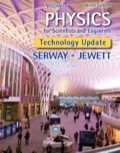
Two spheres having masses M and 2M and radii R and 3R, respectively, are simultaneously released from rest when the distance between their centers is 12R. Assume the two spheres interact only with each other and we wish to find the speeds with which they collide. (a) What two isolated system models are appropriate for this system? (b) Write an equation from one of the models and solve it for
(a)
The two isolated system models that are appropriate for this system.
Answer to Problem 13.60AP
Conservation of energy and conservation of momentum are the two models that are appropriate for this system.
Explanation of Solution
The masses of the two spheres are
The two isolated system models that are appropriate for this system are conservation of energy and conservation of momentum. In these situations, the energy and momentum is conserved before and after the collision of the bodies. This is also called as the perfect elastic collision.
Conclusion:
Therefore, the conservation of energy and conservation of momentum are the two models that are appropriate for this system.
(b)
The equation from one of the model and estimate the speed
Answer to Problem 13.60AP
The equation from conservation of momentum is
Explanation of Solution
By the conservation of momentum for elastic collision,
Here,
Substitute
Conclusion:
Therefore, the equation from conservation of momentum is
(c)
The equation from one of the other model and estimate the speed
Answer to Problem 13.60AP
The equation from conservation of energy is
Explanation of Solution
By the conservation of energy is,
Here,
Formula to calculate the kinetic energy of the spheres after collide is,
Formula to calculate the potential energy of the spheres before collide is,
Here,
Formula to calculate the potential energy of the spheres after collide is,
Here,
Substitute
Substitute
Conclusion:
Therefore, the equation from one of the other model is
(d)
The values of speeds
Answer to Problem 13.60AP
The value of speed
Explanation of Solution
From equation (III) is,
Substitute
Substitute
Conclusion:
Therefore, the value of speeds
Want to see more full solutions like this?
Chapter 13 Solutions
EBK PHYSICS FOR SCIENTISTS AND ENGINEER
Additional Science Textbook Solutions
Fundamentals Of Thermodynamics
Chemistry: Atoms First
Campbell Essential Biology (7th Edition)
Human Biology: Concepts and Current Issues (8th Edition)
Cosmic Perspective Fundamentals
 Classical Dynamics of Particles and SystemsPhysicsISBN:9780534408961Author:Stephen T. Thornton, Jerry B. MarionPublisher:Cengage Learning
Classical Dynamics of Particles and SystemsPhysicsISBN:9780534408961Author:Stephen T. Thornton, Jerry B. MarionPublisher:Cengage Learning University Physics Volume 3PhysicsISBN:9781938168185Author:William Moebs, Jeff SannyPublisher:OpenStax
University Physics Volume 3PhysicsISBN:9781938168185Author:William Moebs, Jeff SannyPublisher:OpenStax Principles of Physics: A Calculus-Based TextPhysicsISBN:9781133104261Author:Raymond A. Serway, John W. JewettPublisher:Cengage Learning
Principles of Physics: A Calculus-Based TextPhysicsISBN:9781133104261Author:Raymond A. Serway, John W. JewettPublisher:Cengage Learning Modern PhysicsPhysicsISBN:9781111794378Author:Raymond A. Serway, Clement J. Moses, Curt A. MoyerPublisher:Cengage Learning
Modern PhysicsPhysicsISBN:9781111794378Author:Raymond A. Serway, Clement J. Moses, Curt A. MoyerPublisher:Cengage Learning College PhysicsPhysicsISBN:9781938168000Author:Paul Peter Urone, Roger HinrichsPublisher:OpenStax College
College PhysicsPhysicsISBN:9781938168000Author:Paul Peter Urone, Roger HinrichsPublisher:OpenStax College Physics for Scientists and Engineers: Foundations...PhysicsISBN:9781133939146Author:Katz, Debora M.Publisher:Cengage Learning
Physics for Scientists and Engineers: Foundations...PhysicsISBN:9781133939146Author:Katz, Debora M.Publisher:Cengage Learning





